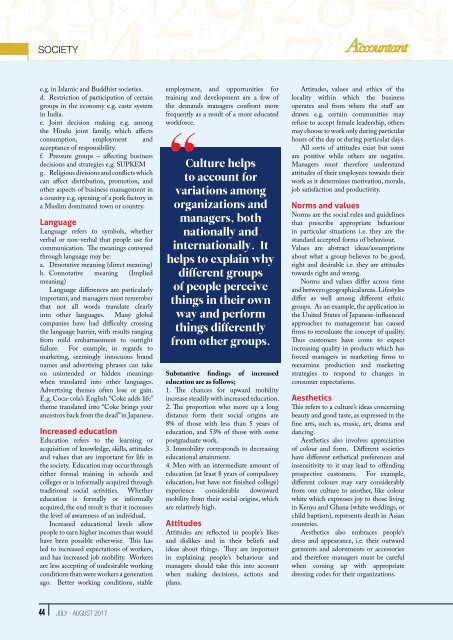The-Accountant-Jul-Aug-2017
Create successful ePaper yourself
Turn your PDF publications into a flip-book with our unique Google optimized e-Paper software.
SOCIETY<br />
e.g. in Islamic and Buddhist societies.<br />
d. Restriction of participation of certain<br />
groups in the economy e.g. caste system<br />
in India.<br />
e. Joint decision making e.g. among<br />
the Hindu joint family, which affects<br />
consumption, employment and<br />
acceptance of responsibility.<br />
f. Pressure groups – affecting business<br />
decisions and strategies e.g. SUPKEM<br />
g. Religious divisions and conflicts which<br />
can affect distribution, promotion, and<br />
other aspects of business management in<br />
a country e.g. opening of a pork factory in<br />
a Muslim dominated town or country.<br />
Language<br />
Language refers to symbols, whether<br />
verbal or non-verbal that people use for<br />
communication. <strong>The</strong> meanings conveyed<br />
through language may be:<br />
a. Denotative meaning (direct meaning)<br />
b. Connotative meaning (Implied<br />
meaning)<br />
Language differences are particularly<br />
important, and managers must remember<br />
that not all words translate clearly<br />
into other languages. Many global<br />
companies have had difficulty crossing<br />
the language barrier, with results ranging<br />
from mild embarrassment to outright<br />
failure. For example, in regards to<br />
marketing, seemingly innocuous brand<br />
names and advertising phrases can take<br />
on unintended or hidden meanings<br />
when translated into other languages.<br />
Advertising themes often lose or gain.<br />
E.g. Coca-cola’s English “Coke adds life”<br />
theme translated into “Coke brings your<br />
ancestors back from the dead” in Japanese.<br />
Increased education<br />
Education refers to the learning or<br />
acquisition of knowledge, skills, attitudes<br />
and values that are important for life in<br />
the society. Education may occur through<br />
either formal training in schools and<br />
colleges or is informally acquired through<br />
traditional social activities. Whether<br />
education is formally or informally<br />
acquired, the end result is that it increases<br />
the level of awareness of an individual.<br />
Increased educational levels allow<br />
people to earn higher incomes than would<br />
have been possible otherwise. This has<br />
led to increased expectations of workers,<br />
and has increased job mobility. Workers<br />
are less accepting of undesirable working<br />
conditions than were workers a generation<br />
ago. Better working conditions, stable<br />
employment, and opportunities for<br />
training and development are a few of<br />
the demands managers confront more<br />
frequently as a result of a more educated<br />
workforce.<br />
Culture helps<br />
to account for<br />
variations among<br />
organizations and<br />
managers, both<br />
nationally and<br />
internationally. It<br />
helps to explain why<br />
different groups<br />
of people perceive<br />
things in their own<br />
way and perform<br />
things differently<br />
from other groups.<br />
Substantive findings of increased<br />
education are as follows;<br />
1. <strong>The</strong> chances for upward mobility<br />
increase steadily with increased education.<br />
2. <strong>The</strong> proportion who move up a long<br />
distance form their social origins are<br />
8% of those with less than 5 years of<br />
education, and 53% of those with some<br />
postgraduate work.<br />
3. Immobility corresponds to decreasing<br />
educational attainment.<br />
4. Men with an intermediate amount of<br />
education (at least 8 years of compulsory<br />
education, but have not finished college)<br />
experience considerable downward<br />
mobility from their social origins, which<br />
are relatively high.<br />
Attitudes<br />
Attitudes are reflected in people’s likes<br />
and dislikes and in their beliefs and<br />
ideas about things. <strong>The</strong>y are important<br />
in explaining people’s behaviour and<br />
managers should take this into account<br />
when making decisions, actions and<br />
plans.<br />
Attitudes, values and ethics of the<br />
locality within which the business<br />
operates and from where the staff are<br />
drawn e.g. certain communities may<br />
refuse to accept female leadership, others<br />
may choose to work only during particular<br />
hours of the day or during particular days.<br />
All sorts of attitudes exist but some<br />
are positive while others are negative.<br />
Managers must therefore understand<br />
attitudes of their employees towards their<br />
work as it determines motivation, morale,<br />
job satisfaction and productivity.<br />
Norms and values<br />
Norms are the social rules and guidelines<br />
that prescribe appropriate behaviour<br />
in particular situations i.e. they are the<br />
standard accepted forms of behaviour.<br />
Values are abstract ideas/assumptions<br />
about what a group believes to be good,<br />
right and desirable i.e. they are attitudes<br />
towards right and wrong.<br />
Norms and values differ across time<br />
and between geographical areas. Lifestyles<br />
differ as well among different ethnic<br />
groups. As an example, the application in<br />
the United States of Japanese-influenced<br />
approaches to management has caused<br />
firms to reevaluate the concept of quality.<br />
Thus customers have come to expect<br />
increasing quality in products which has<br />
forced managers in marketing firms to<br />
reexamine production and marketing<br />
strategies to respond to changes in<br />
consumer expectations.<br />
Aesthetics<br />
This refers to a culture’s ideas concerning<br />
beauty and good taste, as expressed in the<br />
fine arts, such as, music, art, drama and<br />
dancing.<br />
Aesthetics also involves appreciation<br />
of colour and form. Different societies<br />
have different esthetical preferences and<br />
insensitivity to it may lead to offending<br />
prospective customers. For example,<br />
different colours may vary considerably<br />
from one culture to another, like colour<br />
white which expresses joy to those living<br />
in Kenya and Ghana (white weddings, or<br />
child baptism), represents death in Asian<br />
countries.<br />
Aesthetics also embraces people’s<br />
dress and appearance, i.e. their outward<br />
garments and adornments or accessories<br />
and therefore managers must be careful<br />
when coming up with appropriate<br />
dressing codes for their organizations.<br />
44 JULY - AUGUST <strong>2017</strong>

















